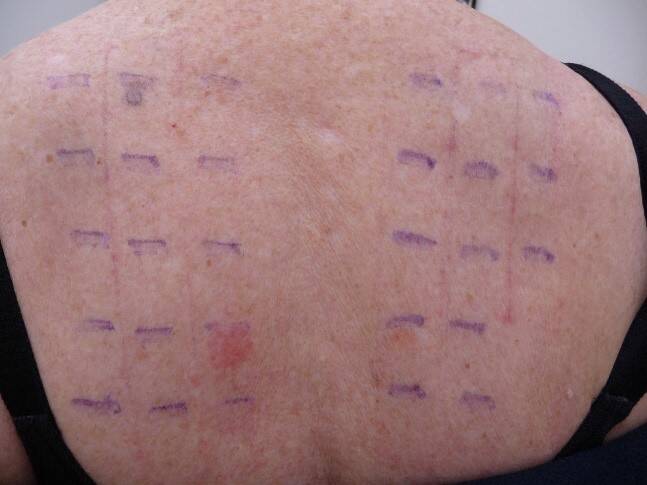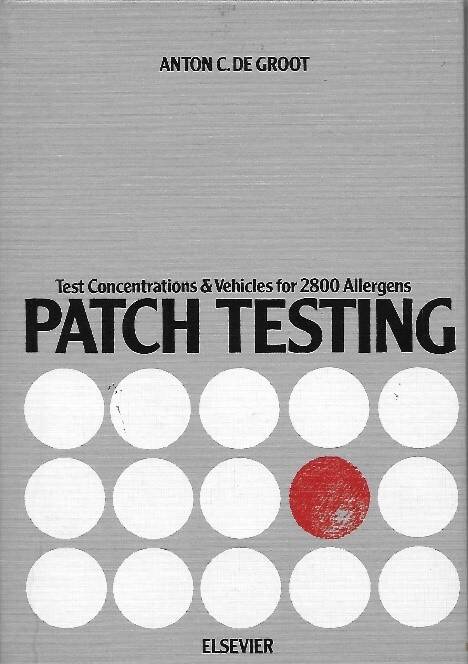Patch testing: the complete story from 1986 to 2022
What is patch testing?
Patch testing is the English term for epicutaneous ('on-the-skin') allergological examination. This is the diagnostic method for demonstrating contact allergy, a form of hypersensitivity (type IV allergy, delayed type hypersensitivity), which can lead to allergic contact dermatitis upon contact with the substance on the skin. A person can become allergic to all kinds of materials: metals, medicines, dyes, adhesives, perfumes, essential oils, cosmetics and ingredients, rubber, plastic, plants, flowers, oils, you name it. Well-known examples of allergens (substances that cause contact allergy) are metals (especially in the past: earrings, suspenders [if you remember what they are], the buttons of a denim trouser), hair dye due to the ingredient paraphenylenediamine and the henna tattoo, which also contains this dye. Patch testing is performed by dermatologists on patients who have eczema and in whom it is suspected that contact allergy is the cause or plays a role in that eczema. Sometimes it is immediately clear, such as in the case of an allergy to a henna tattoo or hair dye (eczema of the head, face, ears, eyelids), but sometimes completely unclear. Patch tests are performed in all such patients to find or confirm the cause of their eczema or to exclude contact allergy as the cause. In Europe, the European baseline series of about 28 allergens, which most frequently cause contact allergy, is always tested, supplemented with the patient's own contact materials and often specialized trays of allergens (e.g. fragrances, glues, drugs, et cetera), depending on the patient history. These substances are applied in plastic or aluminum tubs on the back and fixed with plasters. After 2 days everything is taken off the back and the tests are read at that time, 1 or 2 days later for a second time and if done properly also some 5 days later. A positive reaction, which is proof of contact allergy, shows itching, redness, swelling of the skin, and possibly blisters. More information about patch testing can be found on this page, just below 'List of Dutch publications'.


Strongly positive patch test reaction (+++) with redness (erythema), oedema and blisters
Positive patch test reaction on the lower back left; the ink marks indicate where the allergens have been placed (in-between) to facilitate reading the days after removing the allergens and patches
Correct concentration and vehicle
The allergens must be applied in the correct concentration (which can roughly vary from 0.01% to 100%) and the correct vehicle (base, solvent) for a reliable test result. The vehicle is usually petroleum jelly (soft paraffin, petrolatum), sometimes water, alcohol, acetone or methyl ethyl ketone. The choice of the base depends on the properties of the allergen, which should enter the skin maximally from the vehicle in order to give a positive patch test reaction. The concentration of the substance is also very important. If you choose a concentration that is too low, the amount of the allergen is too low to evoke a positive patch test reaction, even in patients who are allergic to it. The reaction is then negative, while it should have been positive: false-negative.
On the other hand, if too high a concentration is chosen, this can lead to extremely strong patch test reactions with spreading eczema in people who are (very) allergic to it or even to 'active sensitization'. This means that the patient was not yet allergic to this allergen before testing, but becomes allergic to it as a result of the test. A too high concentration can also lead to an irritation reaction of the skin, which may be very difficult to distinguish from a 'real' allergic reaction. In such cases contact allergy may be diagnosed, whereas the patient is not allergic at all. This is called a false-positive reaction. In extreme cases, testing an irritating substance could even cause a chemical burn in the patient's skin. All the more reason to use the right concentration and the right vehicle. There are approximately 650 allergens commercially available for patch testing. For these substances, it is largely known what the optimal concentrations and bases are. However, people may have skin contact with many more materials and these may therefore also have to be patch tested. So how do you determine an optimal test concentration and vehicle? This is where my book Patch testing comes into view.
Patch testing: the book
Previously, our books Unwanted effects of cosmetics and drugs used in dermatology (first and second editions, 1983 and 1985) had been published. In these books, Johan Nater and I had included many test concentrations and vehicles from various textbooks. But many test concentrations, which we found in original publications on contact allergy, were not present in the books in question. In other words, when someone was looking for data on a less common or rare allergen, an extensive literature search had to be done to find that data. If you could find it at all: articles about contact allergy were published in a large variety of scientific journals. At that time there were hardly any personal computers, let alone databases such as PubMed, where nowadays one only needs to enter a few keywords to search thousands of journals. So I soon got the idea to go through all the literature on contact allergy that listed concentrations and vehicles for patch testing and to bundle the data in a new book: Patch testing.


The first edition of Patch testing from 1986, published by Elsevier, and the fifth edition from 2022, 36 (!) years later, self-published (acdegroot publishing). The number of substances for which test concentrations and vehicles are given has increased from 2800 to 5200, the number of pages from 295 to 615 (more than doubling) and the number of literature references increased from 295 to 1068. The design has remained essentially the same, but many errors in the nomenclature used in the literature have been corrected over time. The allergens have now also been given CAS numbers (Chemical Abstract Service, www.cas.org), so that their identity is better established

